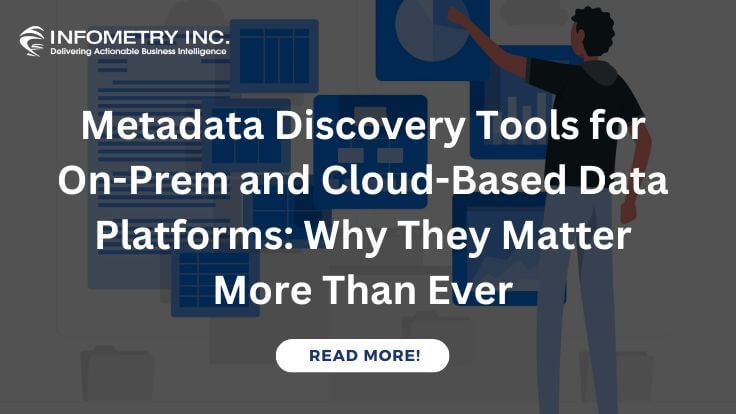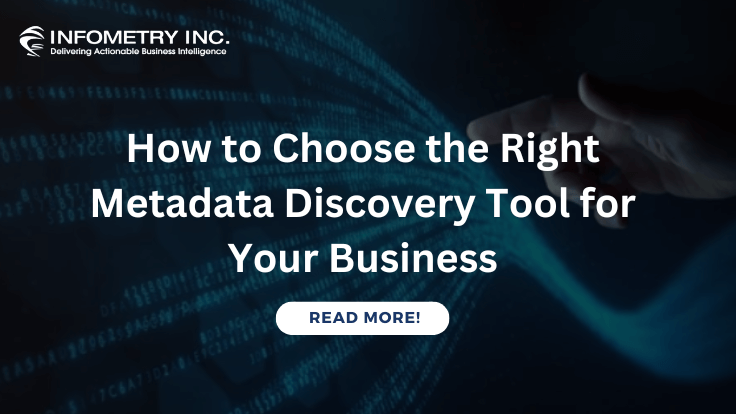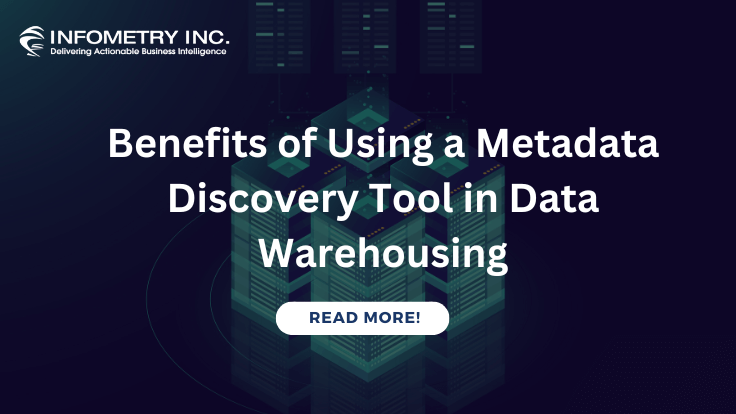
Delving into Tableau: Unraveling its Uses and Advantages
March 13, 2024
Unraveling the Secrets of Enterprise Performance Management
March 19, 2024In the ever-evolving landscape of data management, Extract, Transform, and Load (ETL) processes play a pivotal role in ensuring the seamless flow of information within an organization. In this blog post, we will delve into the intricacies of ETL, shedding light on its significance, components, and the role of Infometry in optimizing these processes.
Understanding ETL:
ETL, an acronym for Extract, Transform, Load, represents a set of procedures and techniques that facilitate the extraction of data from various sources, its transformation according to predefined rules, and loading into a target data warehouse or database. This systematic approach is fundamental for maintaining data integrity, consistency, and accessibility.
Extraction:
The process begins with the extraction of data from diverse sources such as databases, applications, or external systems.
Infometry, a leading player in data management solutions, provides tools and technologies to streamline and automate the extraction phase. Their expertise ensures a smooth and efficient retrieval of data from source systems.
Transformation:
Once data is extracted, it undergoes a series of transformations to conform to the requirements of the target database or data warehouse.
Infometry’s ETL solutions offer a range of transformation capabilities, from data cleansing and normalization to aggregation and enrichment. This ensures that the data is not only accurate but also aligned with the business needs.
Loading:
The final step involves loading the transformed data into the destination, which is typically a data warehouse for analytical processing.
Infometry’s ETL tools excel in loading data efficiently, optimizing the process for enhanced performance and scalability. Whether it’s batch loading or real-time streaming, their solutions cater to diverse data loading requirements.
Significance of ETL in Data Management:
ETL processes are the backbone of effective data management for several reasons:
Data Integration:
ETL ensures the integration of data from disparate sources into a unified, coherent format, enabling a holistic view of organizational information.
Data Quality:
Through data cleansing and transformation, ETL enhances the quality and accuracy of information, fostering better decision-making processes.
Business Intelligence:
ETL feeds data warehouses, supporting robust business intelligence and analytics initiatives. It enables organizations to derive valuable insights from their data.
Regulatory Compliance:
In industries with stringent regulatory requirements, ETL processes help maintain compliance by ensuring data accuracy, traceability, and security.
Best Practices for Successful ETL Process:
Efficient Extract, Transform, Load (ETL) processes are essential for maintaining data integrity and supporting robust analytics in modern organizations. Here are some best practices to ensure a successful ETL process:
Define Clear Objectives:
Clearly define the objectives and goals of your ETL process. Understand the business requirements and the expected outcomes to tailor your ETL workflows accordingly.
Understand Source Data:
Thoroughly understand the structure and format of the source data. This includes data types, data ranges, and any potential data quality issues. A comprehensive understanding of the source data is crucial for effective transformations.
Data Profiling and Cleaning:
Implement data profiling techniques to analyze and assess the quality of source data. Cleanse and standardize data as it is extracted to ensure accuracy and consistency in the target system.
Incremental Loading:
Whenever possible, use incremental loading techniques to update only the changed or new data. This reduces processing time and minimizes the load on both source and target systems.
Data Validation:
Implement robust data validation mechanisms at various stages of the ETL process. This ensures that data is accurate and meets the defined business rules. Identify and handle exceptions appropriately.
Scalability and Performance:
Design your ETL processes with scalability in mind. Consider the potential growth of data volumes and design workflows that can handle increasing loads without compromising performance.
Metadata Management:
Maintain comprehensive metadata about the ETL process. This includes information about data lineage, transformations applied, and data dependencies. Proper metadata management facilitates easier troubleshooting and auditing.
Error Handling and Logging:
Establish a robust error-handling mechanism to capture and log errors during the ETL process. Detailed logs aid in identifying and resolving issues promptly.
Testing and Validation:
Conduct thorough testing of your ETL processes in a controlled environment before deploying them to production. Perform unit tests, integration tests, and end-to-end tests to validate the accuracy and efficiency of the ETL workflows.
Documentation:
Document the ETL process comprehensively, including data mappings, transformations, and dependencies. This documentation serves as a valuable resource for the development team and future maintenance efforts.
Security Measures:
Implement security measures to safeguard sensitive data during the ETL process. Encrypt data during transmission and ensure that only authorized personnel have access to the ETL environment.
Monitoring and Performance Tuning:
Set up monitoring tools to keep track of ETL job performance. Regularly monitor key metrics and proactively address any performance issues. Fine-tune the ETL process based on performance analytics.
Version Control:
Implement version control for ETL code and configurations. This ensures that changes can be tracked, rolled back if necessary, and deployed in a controlled manner.
Collaboration and Communication:
Foster collaboration and open communication between data engineers, analysts, and business stakeholders. Regularly review and update ETL processes based on evolving business requirements.
Continuous Improvement:
Embrace a mindset of continuous improvement. Regularly assess the effectiveness of your ETL processes, explore new technologies, and implement enhancements to optimize performance and maintain relevance.
By adhering to these best practices, organizations can establish a solid foundation for successful ETL processes, enabling them to derive maximum value from their data assets.
Tools and Technologies for ETL:
Infometry, as a data management solutions provider, offers a suite of tools and technologies that cater to various aspects of Extract, Transform, and Load (ETL) processes. Here’s a mention of Infometry’s offerings in the context of ETL:
Apache NiFi:
An open-source data integration tool that provides an intuitive web interface for designing ETL workflows. NiFi is highly scalable and supports data routing, transformation, and system mediation.
Apache Spark:
A powerful open-source data processing engine that supports ETL tasks. Spark’s Spark SQL module provides a programming interface for structured data processing, making it suitable for ETL operations.
Apache Kafka:
A distributed streaming platform that is widely used for real-time data streaming and event-driven architectures. Kafka can be integrated into ETL pipelines for handling streaming data.
Talend:
An open-source ETL tool that offers a wide range of data integration and transformation capabilities. Talend provides a user-friendly graphical interface and supports both on-premises and cloud-based ETL workflows.
Informatica PowerCenter:
A popular enterprise-grade ETL tool that provides comprehensive data integration and transformation capabilities. PowerCenter supports various data sources and targets, making it suitable for complex ETL scenarios.
Microsoft SQL Server Integration Services (SSIS):
A part of the Microsoft SQL Server database platform, SSIS is a powerful ETL tool that integrates with other Microsoft products. It offers a visual design interface for building ETL workflows.
IBM InfoSphere DataStage:
An ETL tool by IBM that supports the integration and transformation of large volumes of data. InfoSphere DataStage provides a scalable and parallel processing architecture for efficient ETL operations.
Matillion ETL:
A cloud-native ETL platform designed for data transformation on popular cloud platforms such as Amazon Redshift, Google BigQuery, and Snowflake. Matillion offers a user-friendly interface and pre-built components.
SAS Data Management:
A comprehensive data integration and ETL tool by SAS that supports data quality, data governance, and metadata management. SAS Data Management is suitable for large-scale data integration projects.
Alteryx:
A self-service analytics platform that includes ETL capabilities. Alteryx allows data analysts to build and execute ETL workflows without the need for extensive coding.
Fivetran:
A cloud-based data integration platform that specializes in automated data pipelines. Fivetran supports a wide range of data sources and automatically syncs data to cloud warehouses.
AWS Glue:
A fully managed ETL service provided by Amazon Web Services (AWS). AWS Glue simplifies the ETL process by automatically discovering, cataloguing, and transforming data stored on AWS.
Oracle Data Integrator (ODI):
An ETL tool by Oracle that provides seamless integration with Oracle databases. ODI supports both batch and real-time data integration scenarios.
Pentaho Data Integration:
An open-source ETL tool that offers a graphical design interface for building data integration and transformation workflows. Pentaho supports a wide range of data sources and targets.
SnapLogic:
A cloud-based ETL platform that simplifies data integration and supports both cloud and on-premises data sources. SnapLogic uses a visual design interface with pre-built connectors.
Infometry’s above-mentioned suite of ETL tools and technologies is positioned to empower organizations to manage their data efficiently, ensuring data quality, and supporting the seamless integration of information across diverse sources. It’s essential to consult with Infometry’s experts to tailor their solutions to the specific needs of your organization’s data ecosystem.
Role of Infometry in ETL Optimization:
Infometry stands out in the realm of ETL with its innovative solutions and commitment to optimizing data processes. Some key aspects of Infometry’s contribution include:
Automation:
Infometry leverages automation to accelerate ETL processes, reducing manual intervention and minimizing the risk of errors.
Scalability:
The scalability of Infometry’s ETL solutions ensures that organizations can adapt to growing data volumes without compromising performance.
Real-time Processing:
With a focus on real-time data integration, Infometry empowers organizations to make timely, data-driven decisions in dynamic business environments.
Flexibility:
Infometry’s ETL tools offer flexibility in terms of data formats, sources, and destinations, catering to the diverse needs of modern enterprises.
ETL Challenges and Future Trends
Challenges in ETL and How Infometry Addresses Them:
Data Integration Complexity:
Challenge: Managing diverse data sources with varying formats and structures can lead to integration complexities.
Solution by Infometry: Infometry’s Harmonize simplifies data integration by providing a unified platform to connect, transform, and manage data from disparate sources, reducing complexity and ensuring seamless integration.
Scalability Issues:
Challenge: Traditional ETL processes may struggle to scale with increasing data volumes and growing business needs.
Solution by Infometry: Infometry’s scalable solutions are designed to handle large datasets efficiently, ensuring optimal performance even as data volumes expand.
Real-time Data Processing:
Challenge: Real-time data integration is crucial for businesses, but it poses challenges in terms of processing speed and responsiveness.
Solution by Infometry: Infometry specializes in real-time data integration, enabling organizations to process and analyze data as it arrives, facilitating timely decision-making.
Data Quality and Cleansing:
Challenge: Maintaining data quality throughout the ETL process is a common challenge, leading to issues in reporting and analytics.
Solution by Infometry: Infometry’s ETL tools incorporate data profiling and cleansing features, ensuring that data is accurate, consistent, and adheres to predefined quality standards.
Automation and Efficiency:
Challenge: Manual intervention in ETL processes can lead to errors and inefficiencies, impacting overall workflow.
Solution by Infometry: Infometry emphasizes automation in ETL workflows, reducing manual efforts, improving efficiency, and minimizing the risk of human errors.
Data Security Concerns:
Challenge: Securing sensitive data during extraction, transformation, and loading is a critical concern for organizations.
Solution by Infometry: Infometry’s ETL solutions incorporate robust security measures to ensure the confidentiality and integrity of data throughout the entire data processing lifecycle.
Future Trends in ETL and How Infometry Addresses Them:
Cloud-Native ETL:
Trend: The future of ETL involves a shift towards cloud-native solutions for flexibility and scalability.
Infometry’s Approach: Infometry supports cloud-based data integration, ensuring that organizations can seamlessly adapt to evolving cloud technologies and leverage platforms like AWS, Azure, or Google Cloud.
Advanced Analytics and AI Integration:
Trend: ETL processes are evolving to support advanced analytics and integration with artificial intelligence (AI) for enhanced insights.
Infometry’s Approach: Infometry’s suite is designed to integrate seamlessly with advanced analytics platforms and AI solutions, allowing organizations to derive meaningful insights from their data.
Data Governance and Compliance:
Trend: Increasing emphasis on data governance and compliance requires ETL solutions to incorporate features for metadata management and adherence to regulatory standards.
Infometry’s Approach: Infometry places importance on metadata management, ensuring organizations can track and manage data lineage for compliance purposes.
Self-Service ETL:
Trend: The trend towards self-service analytics includes a desire for business users to have more control over ETL processes.
Infometry’s Approach: Infometry’s user-friendly interfaces empower both technical and non-technical users to design, deploy, and manage ETL workflows, fostering a self-service approach.
Hybrid and Multi-Cloud ETL:
Trend: Organizations are increasingly adopting hybrid and multi-cloud strategies, necessitating ETL solutions that can seamlessly operate in diverse cloud environments.
Infometry’s Approach: Infometry’s solutions are designed to be flexible and support hybrid and multi-cloud scenarios, providing organizations with the agility to choose their preferred cloud platforms.
Conclusion:
In conclusion, ETL processes are the backbone of effective data management, and Infometry emerges as a key player in optimizing these critical workflows. As organizations navigate the complexities of data integration, transformation, and loading, Infometry’s innovative solutions provide the necessary tools and expertise to ensure a seamless and efficient ETL journey. Embrace the power of ETL with Infometry for a data-driven future.
Infometry addresses current ETL challenges by providing robust solutions for data integration, scalability, real-time processing, data quality, automation, and security. Looking towards the future, Infometry aligns with emerging trends such as cloud-native ETL, advanced analytics integration, data governance, self-service capabilities, and adaptability to hybrid and multi-cloud environments.




